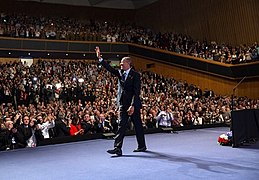International Convention Center (Jerusalem)
Merkaz HaKongresim HaBeinLeumi | |
Binyanei HaUma | |
 ICC in January 2006 | |
 | |
| Location | Givat Ram, Jerusalem |
|---|---|
| Coordinates | 31°47′10″N 35°12′10″E / 31.7862°N 35.2027°E |
| Owner | Jewish Agency for Israel |
| Capacity | 3,104 (auditorium) |
| Construction | |
| Built | 1950–63 |
| Opened | 1956 |
| Architect | Zeev Rechter |
| Website | |
| ICC.co.il | |
The International Convention Center (Hebrew: מרכז הקונגרסים הבינלאומי, Merkaz HaKongresim HaBeinLeumi), commonly known as Binyanei HaUma (Hebrew: בנייני האומה, lit. Buildings of the nation), is a concert hall and convention center in Giv'at Ram in Jerusalem.
History
[edit]Binyanei Ha'Uma was first envisioned by Alexander Ezer (who later became its managing director) and planned by architect Zeev Rechter who won the design competition in 1949.[1]
The complex was under construction from 1950 to 1963.[2] In 1953, it was the site of Israel's first international exhibition, the Conquest of the Desert. In 1960, the World Zionist Organization convened there.
The period of economic difficulty and austerity in the first decade of Israeli independence led to frequent disruption in construction due to lack of funds, and the project was sometimes disparagingly called Hirbet HaUma, the National Ruin.[citation needed] Rechter's design was a solid structure faced in Jerusalem stone. Instead of a monumental relief by artists Joseph Zaritsky and Yitzhak Danziger as originally planned, the facade was covered with azure-coloured glass panels.
Capacity and functions
[edit]Located opposite the Jerusalem Central Bus Station at the western entrance to town, the centre houses 27 halls capable of seating over 10,000 people, and is a member of the International Association of Convention Centres (AIPC) and ICCA and conforms to their international standards. Its largest hall, the Menachem Ussishkin auditorium, seats 3,104. In all, 12,000 square metres of exhibit space extend over two levels and ten display areas.[3]
Binyanei Ha'Uma is the home of the Jerusalem Symphony Orchestra.[4] The complex has hosted many international events, among them the Eurovision Song Contest 1979, Eurovision Song Contest 1999 and the Jerusalem International Book Fair. The trial of John Demjanjuk was held there.[5]
Development plans
[edit]Plans are being discussed to enlarge the ICC by 30,000 square meters, doubling of the parking space, adding three office towers, commercial space and a hotel.
Cultural references
[edit]The Center serves as a historical setting in Robert J. Sawyer's 1997 novel Frameshift. It serves as a post-World War II venue for a war crimes trial, in which a Nazi camp guard is prosecuted for atrocities against the Jewish prisoners.[6]
Gallery
[edit]-
Jerusalem Convention Center (Binyanei HaUma) shortly after completion, circa 1960
-
25th Zionist Congress, 1960
-
The fourth Jerusalem book fair, in the International Convention Center, 1969. From the collections of the National Library of Israel.
-
International Multi-Cultural Festival with Rev. Dr. Jaerock Lee, 2009
-
US President Barack Obama waving students after the speech, March 2013
See also
[edit]References
[edit]- ^ Sliding up the Rechter Scale, Haaretz
- ^ "Binyanei Ha'uma history". Archived from the original on 2016-03-12. Retrieved 2017-10-23.
- ^ ICC website Archived 2007-05-12 at the Wayback Machine
- ^ "An International Convention Center deserving of the name". GoJerusalem.com. Retrieved 2010-08-06.
- ^ Jerusalem: Nightlife & the Arts Fodor's
- ^ Sawjer, Robert J. Frameshift. Tor, 1997, pp. 46–51.





